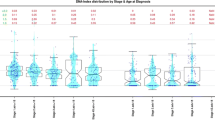Abstract
Neuroblastoma is a heterogeneous childhood tumour of the sympathetic nervous system, in which deletions of chromosomal region 1p and amplification of the MYCN oncogene correlate with aggressive tumour behaviour. However, the majority of neuroblastoma tumours show neither of these aberrations, indicating that other chromosomal regions may be involved in tumorigenesis. Here, we report findings of loss of heterozygosity (LOH) on chromosome 3. In our neuroblastoma material, nine of 59 (15.3%) tested tumours showed allelic loss of chromosome 3p markers. We found significant clinical and biological differences between tumours with the loss of one entire chromosome 3 vs tumours with partial loss in chromosome region 3p. All children with tumours with whole chromosome 3 loss are long-term survivors, whereas all children with tumours showing partial 3p LOH have died from tumour progression. A consensus region found to be deleted in all the tumours with 3p deletions was defined by markers D3S1286 and D3S1295, i.e. 3p25.3-p14.3, distal to the FHIT gene.
Similar content being viewed by others
Author information
Authors and Affiliations
Rights and permissions
About this article
Cite this article
Ejeskär, K., Aburatani, H., Abrahamsson, J. et al. Loss of heterozygosity of 3p markers in neuroblastoma tumours implicate a tumour-suppressor locus distal to the FHIT gene. Br J Cancer 77, 1787–1791 (1998). https://doi.org/10.1038/bjc.1998.297
Issue Date:
DOI: https://doi.org/10.1038/bjc.1998.297
- Springer Nature Limited
This article is cited by
-
Multiple mechanisms disrupt the let-7 microRNA family in neuroblastoma
Nature (2016)
-
The RASSF gene family members RASSF5, RASSF6 and RASSF7 show frequent DNA methylation in neuroblastoma
Molecular Cancer (2012)
-
Molecular and genetic bases of neuroblastoma
International Journal of Clinical Oncology (2012)
-
Chromosomal CGH identifies patients with a higher risk of relapse in neuroblastoma without MYCN amplification
British Journal of Cancer (2007)
-
cDNA array-CGH profiling identifies genomic alterations specific to stage and MYCN-amplification in neuroblastoma
BMC Genomics (2004)




